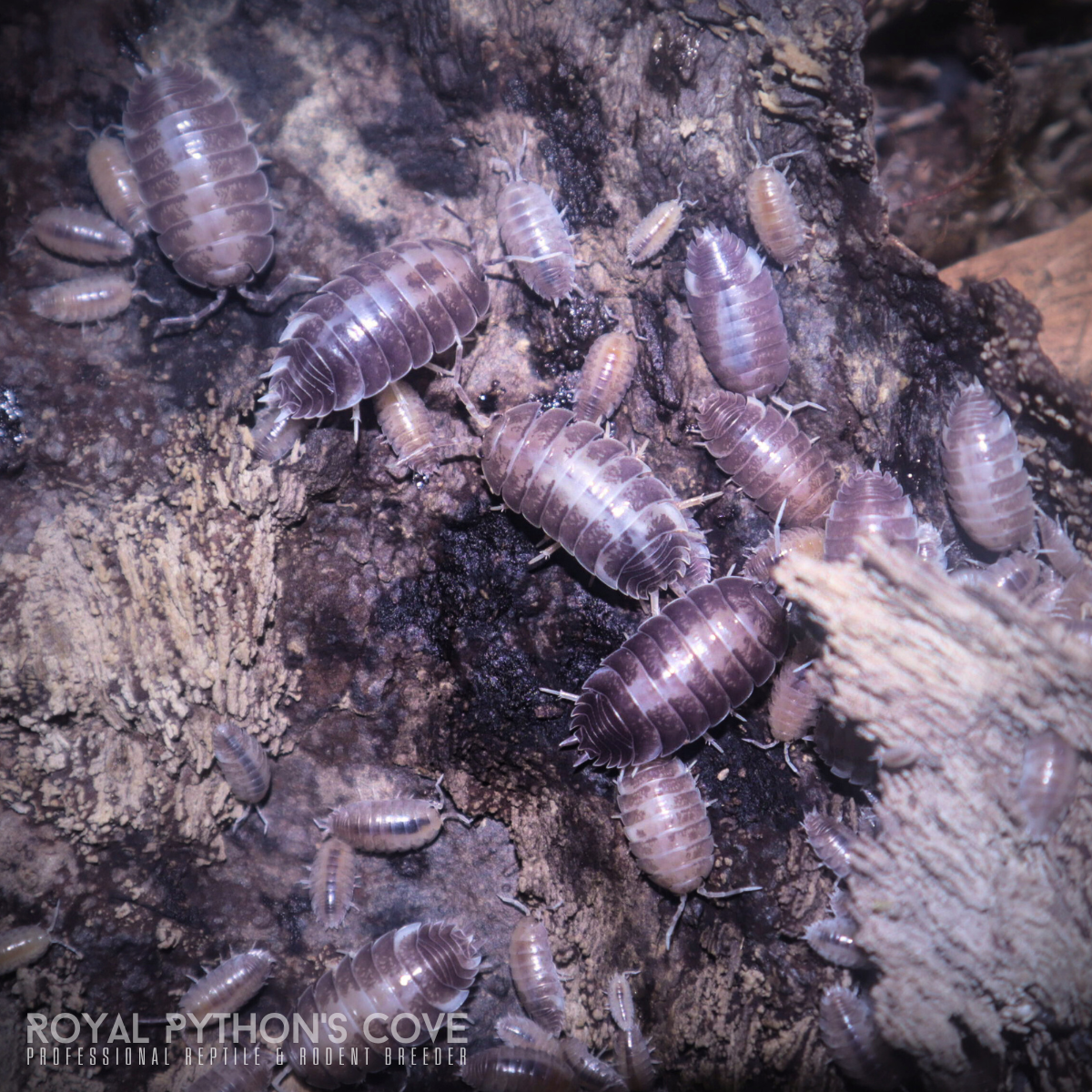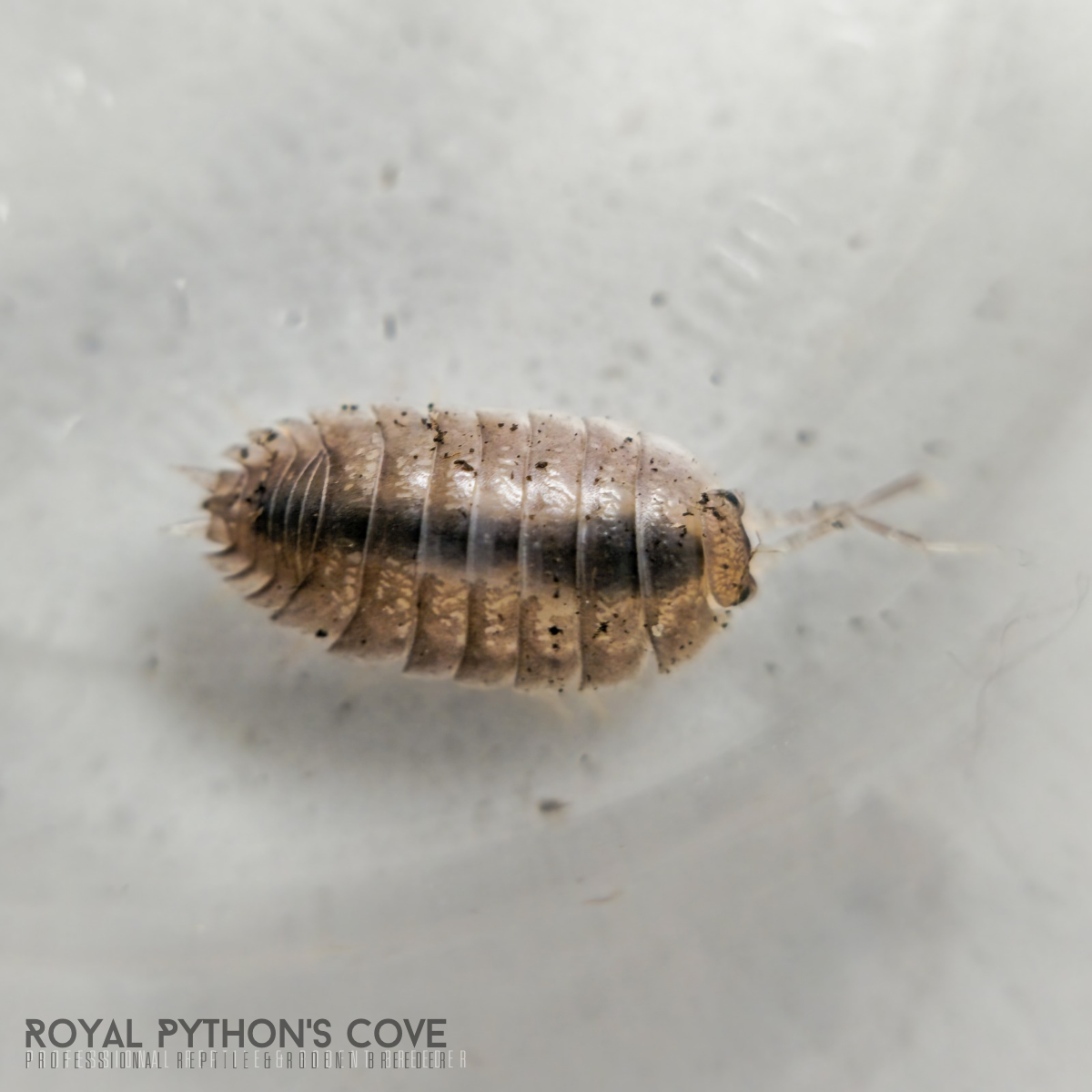Royal Python's Cove
Porcellio laevis "Milkback" Isopods
Porcellio laevis "Milkback" Isopods
Couldn't load pickup availability
Porcellio laevis: Vital Contributors to Ecosystem Health
Milkback Isopods, scientifically known as Porcellio laevis, are important terrestrial crustaceans that play essential roles in vivarium ecosystems, serving as effective cleanup crews. Here’s a comprehensive overview of their functions, preferred habitat, thriving conditions, and recommended cohabitation with other organisms.
Functions in Vivarium Ecosystems
Milkback Isopods enhance the health of vivarium environments through:
- Decomposition: They efficiently break down decaying organic matter, helping to maintain a clean and balanced substrate.
- Nutrient Cycling: By recycling nutrients through their waste, they enrich the substrate, promoting plant growth.
- Aeration: Their burrowing activities aerate the substrate, supporting healthy root development and preventing soil compaction.
- Bioactive Cleanup Crew: They consume leftover food, mold, and debris, reducing the risk of mold outbreaks and pest infestations.
Preferred Habitat
- Substrate: Milkback Isopods thrive in a moist substrate rich in organic material, such as coconut fiber, leaf litter, or peat moss.
- Moisture Levels: They prefer moderate to high humidity (around 50-70%) to prevent desiccation.
- Temperature: The ideal temperature range is between 65-75°F (18-24°C), but they can tolerate some fluctuations.
- Ventilation: Good ventilation is crucial to prevent stagnant air and maintain optimal oxygen levels.
Thriving Conditions
To ensure optimal living conditions for Milkback Isopods, consider the following:
- Hydration: Regular misting helps maintain humidity, and it’s important to provide moist hiding spots.
- Feeding: Offer a balanced diet of fresh vegetables, fruits, and calcium sources (like cuttlebone or calcium powder).
- Substrate Depth: Provide at least 1-2 inches of substrate depth to accommodate their natural burrowing behaviors.
- Compatibility: Avoid overcrowding and ensure plenty of hiding spots and surface area for them to explore.
Recommended Cohabitation
Enhance the biodiversity and functionality of your vivarium by cohabitating Milkback Isopods with:
- Springtails (Collembola): These beneficial organisms aid in the breakdown of organic matter and coexist harmoniously with isopods.
- Dwarf White Isopods (Trichorhina tomentosa): They work together with Milkback Isopods in nutrient cycling and substrate maintenance.
- Earthworms: Living below the substrate, earthworms contribute to soil aeration and nutrient enrichment, enhancing overall ecosystem health.
By fostering a balanced ecosystem with these inhabitants, you can create a thriving vivarium that supports plant growth, maintains cleanliness, and enriches the lives of all its residents.
Share



Shipping Policy & Live Arrival Guarantee
Timeline and Processing
Order Processing Time: All orders are processed within 1-2 business days (Monday to Friday, excluding holidays). Please allow for additional processing time during peak seasons or holidays.
Shipping Days: We ship live insects Monday through Wednesday to ensure that orders do not sit in transit over the weekend. We do not ship live insects on Thursdays or Fridays to avoid delays caused by weekend transit.
Delays: While we do our best to ship all orders on time, please understand that shipping carriers (USPS, UPS, FedEx, etc.) may experience delays that are beyond our control. Please track your shipment regularly for updates.
Temperature Warning
To ensure the safe arrival of your live insects, we take temperature into consideration. The health of your order is our top priority, and we have specific procedures in place for extreme temperatures.
- Cold Weather Shipping (Fall/Winter Months):
During colder months, we include heat packs in all orders to maintain a safe temperature range for your insects. If temperatures are below 40°F (4°C) at any point during transit, we will include a heat pack at no additional cost. - Hot Weather Shipping (Spring/Summer Months):
In warmer months, if temperatures exceed 85°F (29°C), we may delay your order shipment or opt to ship your insects with cool packs or use additional insulation to prevent overheating. We will reach out if we believe weather conditions are too extreme for shipping and discuss the best options for you. - Live Arrival Guarantee:
We guarantee live arrival of your insects only if the package is received within the first 2 hours of delivery (in cases of heat packs or cool packs used). In the event of any issues, please contact us immediately with photographic evidence of the condition of the insects upon arrival.
Shipping to a Hub
Hold for Pickup Option
- Shipping to a Hub:
To minimize potential risks associated with extreme weather or shipping delays, we highly recommend choosing the “Hold for Pickup” option with carriers like UPS or FedEx. This allows your package to be kept at a local hub for pickup rather than sitting in a mail carrier’s truck. This option is available at checkout and provides more control over the timing and condition of your insect order.
Shipping Carriers
Carrier Options:
We ship via USPS, UPS, or FedEx depending on the size, weight, and destination of the order. All live insect shipments are sent via expedited or priority shipping methods to reduce transit time.
Overnight Delivery:
We ship overnight via FedEx. This option automatically includes Live Arrival Guarantee.
Tracking:
A tracking number will be provided once your order ships. Please track your package to stay updated on its estimated delivery time. In case of delays or issues with the tracking, please contact us immediately, and we will assist in resolving the issue.
Live Arrival Guarantee & Shipment Protection
Automatic Shipment Protection: To ensure the well-being of your insects, shipment protection is automatically included in all live insect orders at checkout. This means your order is covered for issues related to shipping conditions, such as delays, extreme weather, or packaging problems.
For 2-Day Express Shipping: Shipment protection applies to all orders, including 2-day express shipments, so you are automatically covered for the duration of transit, even if the insects are in transit for longer than overnight shipping.
How to Ensure Your Insects Arrive Safely
- Live Arrival Guarantee Applies to All Orders with Shipment Protection: The live arrival guarantee is applicable for any live insect order as long as the shipment is received on the first delivery attempt, and shipment protection is active.
- If your insects do not arrive alive, please contact us within 2 hours of delivery with photographic evidence of the insects' condition to qualify for a replacement.
Refunds & Replacements
Refunds
If your insects arrive dead or in poor condition, and the shipment is covered by Shipment Protection, we will issue a replacement or a refund for the cost of the insects (excluding shipping).
- Note: We do not offer refunds for shipping costs due to the nature of live insect shipping.
Replacement
In cases of dead-on-arrival (DOA) insects, we will ask for photographic evidence of the condition of the insects upon delivery. Once confirmed, we will send a replacement order at no additional cost (subject to availability).




